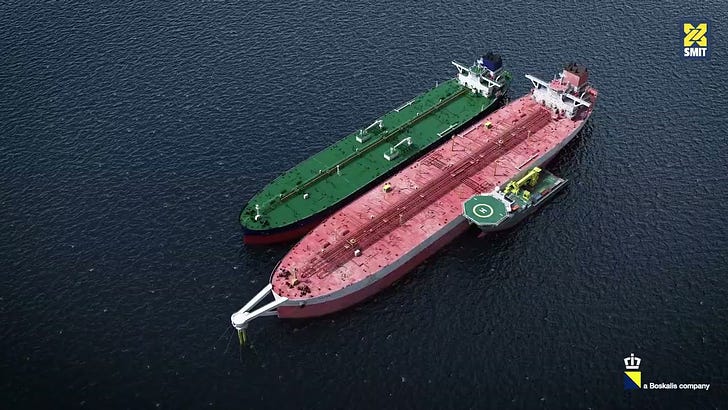FSO Safer: SMIT Salvage - The Safer Plan
What do we know about what SMIT Salvage will do with the Safer?
When the UNDP announced the Operational Plan for the Safer in April 2022, SMIT Salvage was identified as the firm who would be undertaking the actual salvage and transfer of oil off the Safer.1 A month later in May 2022 at the UN pledging event, SMIT put together the above animated video, which showed key aspects of the operation including:
A support vessel will arrive with a specialist crew, board the Safer and start to inspect the cargo and inert gas lines, deck machineries, PV (Pressure Vacuum) breakers and PV valves keeping pressures within the storage tanks in balance, the pump and engine room, and the vessel’s moorings.
Portable inert gas generators to be installed to bring inert gas into storage tanks. (The inert gas, as previously discussed, is needed to ensure that flammable vapours emanating off the oil cargo are neutralised.)
A Very Large Crude Carrier (VLCC) will arrive alongside the Safer.
Oil booms will be installed in the water to assist in absorption in case of any oil spillage.
The ‘manholes’ on deck will be opened and four hydraulic pumps will be lowered into each of the storage tanks. The transfer of the oil into the VLCC will then commence.
Once this is completed, any remaining oil residue will be removed and the tanks will be cleaned.
Remaining dirty water will be piped into the VLCC.
Just under a year later, in March 2023 the UNDP announced that a replacement vessel - the VLCC Nautica - had been purchased. A month after that, a signed contract with SMIT was then confirmed, with parent company Boskalis CEO Peter Berdowski stating on 20 April that:
[t]he Boskalis vessel Ndeavor will depart tomorrow from the port of Rotterdam stocked with all the necessary salvage equipment and I wish the crew all the success in this important mission.
The Ndeavor would sail to Djibouti over three weeks, making final preparations there before heading over to the port of Ras Isa where the Safer is located and proceed to carry out the salvage plan as described above, with an expected timeline of two months from when arriving off the coast of Yemen. Once the plan is executed, the Safer will embark on its last (assisted) voyage to a green yard for scrapping.
In fact, as described in the detailed timeline of the Safer crisis, SMIT Salvage had been involved at least a year earlier:
Also in July 2021, another option to resolve the crisis is floated; it is labelled the “Commercial Option”:
The Fahem Group, a major Yemeni grain trading company headed by Abdullah Mohammed Fahem, sees the major disruption a spill from the Safer would have on their business. They engage with a group called Safe Passage Yemen, “a collection of former diplomats, humanitarian experts, and analysts, mostly based in the U.K.” with an interest in Yemen’s future, plus some British and Dutch diplomats.Their solution to the enormous costs associated with removing the oil from the Safer is to use the proceeds of any sale of the 1.14 million barrels of oil on board, as well as the potential scrap value of the Safer; while no agreement is reached on what to do with any profit from the operation, the Houthis expect it would go to their administration in Sana’a.Fahem engages the services of the legendary Dutch marine salvage firm SMIT Salvage, whose past operations had included the Ever Given stuck in the Suez Canal four months earlier and the Kursk submarine; Smit would run the salvage operation if the plan ever got up.


